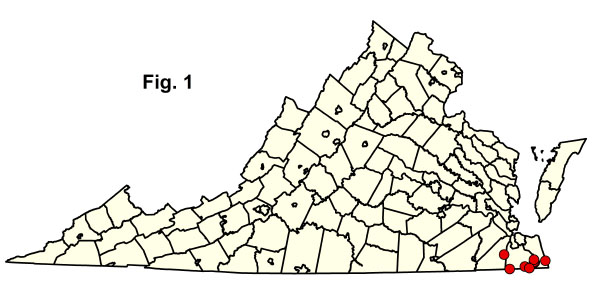
 የጥበቃ እና መዝናኛ መምሪያ
የጥበቃ እና መዝናኛ መምሪያ መጠበቅ. መከላከል. መደሰት.
 የጥበቃ እና መዝናኛ መምሪያ
የጥበቃ እና መዝናኛ መምሪያ  ማውጫ
ማውጫኩሬ ጥድ Woodlands እና Pocosins
This ecological group is characterized by coniferous, pyrophytic woodlands of saturated, oligotrophic, Coastal Plain peatlands. These communities are restricted to southeastern Virginia, eastern North Carolina, and northeastern South Carolina. Although no doubt more widespread in the pre-settlement Virginia landscape, only a few remnants of these communities are currently found in the extreme southeastern part of the state. The largest extant occurrences are in the Great Dismal Swamp National Wildlife Refuge (Cities of Suffolk and Chesapeake) and on remote peat flats beyond the range of wind-tidal flooding along the North Landing River (City of Virginia Beach) and Northwest River (City of Chesapeake). Pond Pine Woodlands and Pocosins have high biomass and consist largely of inflammable woody plants that are specially adapted to frequent, intense burning. All present-day examples in Virginia suffer to some extent from a reduction in fire frequencies or complete suppression of fires. Stand physiognomy and composition reflect responses to gradients of fire frequency and peat depth. Stands known as "high pocosins" are associated with deeper organic soils and more frequent fires; these have only scattered, stunted pond pines (Pinus serotina) emergent from nearly impenetrable evergreen shrub thickets dominated by shining fetterbush (Lyonia lucida), inkberry (Ilex glabra), Carolina laurel (Kalmia carolina), and laurel-leaf greenbrier (Smilax laurifolia). Stands associated with superficial peat and/or longer periods without fire often develop nearly closed canopies of larger pond pines, understories of red maple (Acer rubrum), sweetbay magnolia (Magnolia virginiana var. virginiana), and red bay (Persea palustris), and less dense shrub layers that contain more deciduous species. Few herbaceous species except Virginia chain fern (Anchistea virginica) thrive in pond pine woodlands.
የኩሬ ጥድ ጥቅጥቅ ባለ የሸንኮራ አገዳ (Arundinaria tecta) ላይ "የካኔብሬክስ" በመባል የሚታወቀው በዲስማል ረግረጋማ አካባቢ በጣም አጭር የእሳት መመለሻ ክፍተቶች በነበሩባቸው አካባቢዎች የተለመዱ ነበሩ። በእሳት ማግለል ምክንያት እነዚህ በተከታታይ በወንዝ ባልሆኑ ደኖች ተተክተዋል፣ ምንም እንኳን ተፈጥሯዊ ያልሆኑ አናሎጎች በማጨድ እና በአረም ማጥፊያዎች የሚጠበቁ በኃይል መስመር የመጠቀም መብት ላይ ቢቆዩም።
የኩሬ ፓይን ዉድላንድስ እና ፖኮሲንስ ከሁለቱም ከፔትላንድ አትላንቲክ ኋይት-ሴዳር ደኖች እና ከተደባለቀ የ Evergreen አይነት የወንዝ-አልባ ረግረጋማ ደን ጋር ተመሳሳይነት አላቸው። ከቀድሞው የሚለያዩት ከመጠን በላይ የበላይነት፣ ትልቅ የቁጥቋጦ እፍጋት እና ቀደም ሲል በጣም አጠር ያሉ የእሳት መመለሻ ክፍተቶች ከነበሩባቸው የአፈር መሬቶች ጋር በመተባበር ነው። የወንዝ-አልባ ረግረጋማ ደን (ድብልቅ የ Evergreen ዓይነት) የበለጠ የተለያየ ሽፋን አለው፣ በአሸዋማ ወይም በጥንታዊ የዱና አካባቢዎች ውስጥ እርጥብ ስዋሎችን ይይዛል እና ምናልባትም ከኩሬ ፓይን ማህበረሰቦች በፔት ጥልቀት እና በእሳት ድግግሞሽ ይለያያል። በዚህ ቡድን ውስጥ ያሉ ማህበረሰቦች በአለም አቀፍ ደረጃ ብርቅ ናቸው፣ በፍጥነት እያሽቆለቆለ ነው፣ እና በመበታተን እና ቀጣይነት ያለው የእሳት ተደጋጋሚነት ባለመኖሩ አዋጭ ሊሆኑ አይችሉም።
ዋቢ፡ ዲን (1969)፣ Focazio et al . (1998)፣ ፍሌሚንግ እና ሙርሄድ (1998)፣ ፍሮስት (1995)፣ ስቲቨንስ እና ፓተርሰን (1998)።
 © DCR-DNH, ቶማስ J. Rawinski.
© DCR-DNH, ቶማስ J. Rawinski.

 ።
።

